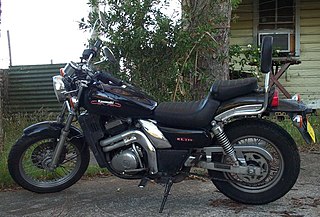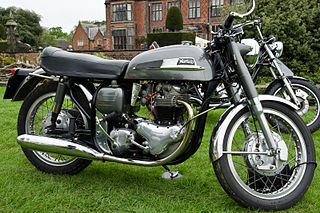The Honda XR series is a range of four-stroke off-road motorcycles that were designed in Japan but assembled all over the world.

The Kawasaki Z650 was produced as a 652 cc (39.8 cu in) standard motorcycle by Kawasaki from 1976 until 1983. It had a four-cylinder four-stroke, DOHC, air-cooled, wet sump engine positioned across the frame with two valves per cylinder and a five-speed gearbox. Designed as a middleweight version of the Kawasaki Z900, the similar-styling had "an attenuated version of the traditional Kawasaki tail fairing". It competed in the market against the smaller SOHC Honda CB650. The Z650 was the epitome of the "Universal Japanese Motorcycle" (UJM).

The Suzuki GS series was Suzuki Motor Corporation's first full range of 4-stroke powered road motorcycles, having previously almost exclusively manufactured 2-stroke machines. Suzuki had produced the 4-stroke Colleda COX 125cc and 93cc 4-stroke single-cylinder machines in 1955 however the rest of Suzuki's production from 1952 to 1976 had been increasingly sophisticated two-stroke road machines, whose ultimate expression was the 750cc 3-cylinder water-cooled GT750.

Syarikat Motosikal dan Enjin Nasional Sdn. Bhd, or known as Modenas for short is a Malaysian national motorcycle company producing various small motorcycle models below 400cc targeted for local market and export. The company's headquarters and factory are located at the small town of Gurun, Kedah, Malaysia.

The Suzuki Katana is a street motorcycle sold between 1981 and 2006 and then since 2019. It was designed in 1979–1980 by Target Design of Germany for Suzuki.

A motorcycle engine is an engine that powers a motorcycle. Motorcycle engines are typically two-stroke or four-stroke internal combustion engines, but other engine types, such as Wankels and electric motors, have been used.

The Kawasaki KZ400/Z400 is a street motorcycle that was produced by Kawasaki between 1974 and 1984. The 398cc displacement of the twin cylinder engine was increased to 443cc for the KZ440/Z440. The later KZ400-J used a 399cc four cylinder engine.

The Yamaha XS750 and XS850 was a line of inline three cylinder motorcycles produced by the Yamaha Motor Corporation from 1976 to 1981 for the worldwide motorcycle market. It was publicly-voted by readers as the 1977 Motorcycle News Machine of the Year, ousting the sitting-winner of four-years, the Kawasaki Z1.

The Eliminator name was first used by Kawasaki in 1985 on the ZL900 A1 motorcycle, creating one of the first "sport cruisers" by using a sport bike engine in a cruiser frame. Since then, the name has been used on a variety of models ranging from 124 cc to 997 cc in engine displacement.

The Kawasaki triples were a range of 250 to 750 cc motorcycles made by Kawasaki from 1968 to 1980. The engines were air-cooled, three-cylinder, piston-controlled inlet port two-strokes with two exhaust pipes exiting on the right side of the bike, and one on the left. It was the first production street motorcycle with capacitor discharge ignition (CDI). Right from the first triple model, the 1968 Mach III H1 500 cc, it was a sales success that gained a reputation for almost unmatched acceleration as well as an air of danger for inexperienced riders trying to cope with the bike's increased power to weight ratio over any previously available stock motorcycles.

The Kawasaki Z1 is a four-cylinder, air-cooled, double-overhead camshaft, carbureted, chain-drive motorcycle introduced in 1972 by Kawasaki. Following the introduction of Honda's CB750 in 1968, the Z1 helped popularize the in-line, across-the-frame four-cylinder, a format that became known as the Universal Japanese Motorcycle or UJM.

The Kawasaki Kz1000 or Z1000 is a motorcycle made in Japan by Kawasaki, manufacturing commenced in September 1976 for the 1977 model year. The Z1000A1 was an upgraded model to replace the 1976 Kawasaki KZ900 (Z900), which in turn replaced the Z1 launched in 1972 in the Z series. It has an inline-four cylinder engine and a 5-speed transmission, in a 'one down and four up' configuration. Producing about 90 hp, it was one of the fastest production motorcycles of the era. The police model continued in production until 2005.

The Suzuki T series was a series of motorcycle manufactured by Suzuki that ran from approximately 1963 through 1977 in various engine displacements between 90 and 500 cc.

The Kawasaki W series is a line of vertical-twin standard motorcycles motorcycles made by Kawasaki beginning in 1965. First sold as a 1966 model in the North American market, the initial Kawasaki W1 had the largest engine displacement of any model manufactured in Japan at the time.

The Dominator is a twin cylinder motorcycle developed by Norton to compete against the Triumph Speed Twin. The original Dominator was designed in 1947 and 1948 by Bert Hopwood, who had been on the Speed Twin design team at Triumph. Available for sale from mid 1949, this design set the pattern for Norton twins for the next 30 years.

The BSA A7 was a 500cc motorcycle model range made by Birmingham Small Arms Company (BSA) at its factory in Armoury Road, Small Heath, Birmingham. The range was launched in 1946 using a 495 cc (30.2 cu in) long stroke engine. An improved 497 cc (30.3 cu in) version based on the BSA A10 engine was launched in 1950. The various A7 models continued in production with minor modifications until 1961/2 when they were superseded by the unit-construction A50 model.

Kawasaki motorcycles are manufactured by the Motorcycle & Engine division of Kawasaki Heavy Industries.

The Kawasaki H2 Mach IV is a 750 cc 3-cylinder two-stroke production motorcycle manufactured by Kawasaki. The H2 was a Kawasaki triple sold from September 1971 through 1975.

The A7 Avenger is a 350 cc (21 cu in) Kawasaki motorcycle sold 1967 through 1971.

Meguro motorcycles were built by Meguro Manufacturing Co motorcycle works (目黒製作所), founded by Nobuji Murata and a high-ranking naval officer, Takaji Suzuki, in 1937. One of the first Japanese motorcycle companies, it became a partner of Kawasaki Heavy Industries Ltd, and was eventually absorbed. Named after a district of Tokyo, Meguro had its roots in Murato Iron Works, which was established in 1924. Meguro Seisakusho, which had once developed a copy of a Harley-Davidson V-twin, was established to design and build gearboxes for the nascent Japanese motorcycle industry. Abe Industries, which had once produced its own motorcycle, merged with Meguro in 1931. The brand is being revived by Kawasaki with a new K3 model to be introduced in Japan on February 1, 2021.


















